TARGETING TROPHY TROUT
TIPS FOR CATCHING THE GATOR TROUT THIS SPRING
by Paul MacInnis

Helena Wilkas (right) and Holly Melder (left), the mother-daughter trout crushing duo!
When the Spawn is ON the Bite is HOT
By April, I start daydreaming about monster seatrout crushing topwater plugs at first light. Usually on the first full or new moon of April, amorous male seatrout gather in the shallows. Just after nightfall they make a drumming sound in hopes of luring egg laden females to a nighttime spawning party. This procreation ritual repeats itself on the new and full moons throughout the summer.
Spawning takes a lot of energy and the big female trout need to load up on calories to fuel and recover from the reproductive process. You ‘ll find them on the grass flats stalking big calorie dense prey like larger finger mullet and chunky pigfish.

Another beauty for Holly.

John Wilkas makes trout fishing a whole family affair.

Author, Paul MacInnis, shows off his catch!
Prime Time Fishing is When the Light is Low
Seatrout have a reflective layer of tissue behind their retinas called tapeta lucidum. I won’t bore you with a detailed explanation, but this means trout can see well in low light. An important consideration is that much of a trout’s food, like mullet, don’t have tapeta lucidum. Big trout tend to feed best during low light when they have a visual advantage over their prey. Consequently, the prime time to target trophy trout is first light until sunrise. There can be another feeding period at sunset and into the night, and overcast conditions can extend a bite all day.
Careful Not to Spook the Fish
Mature trout are wary fish and most of the big ones are caught while wading. You can also get away with minimally invasive craft like kayaks and paddleboards, but bigger boats, even when drifting, put out a pressure wave that can spook all the big trout off a flat. And trolling motors, splashing around, banging a paddle on the hull of a kayak and other such noises are sure to ruin any shot at a good fish.
Keep Moving and Cover Lots of Water
Another consideration is that big trout are loners. They don’t school up like the little guys. Your best shot at catching a good one is to keep moving and cover a lot of water, preferably grass flats with lots of bait.
Along the lines of offering a big bait and covering a lot of water, the classic trophy trout bait is a walk-the-dog style topwater plug like the Super Spook and Top Dog. A shallow running twitch bait is good if the weeds aren’t bad. If the weeds are bad, a big swimbait like the Bass Assassin Boss Shiner rigged weedless can be deadly if buzzed just under the surface where it makes a wake.
The one exception to the big bait rule is plastic shrimp like the ¼ ounce D.O.A., Bass Assassin Shrimp Cocktail and similar fake shrimp from other companies. It seems no trout of any size can resist an easily digestible, protein packed shrimp snack if it bounces right past their nose.

Anna also gets in on the big seatrout action!

Helena Wilkas can’t NOT catch gator trout!
Gearing Up for Big Trout
My standard tackle for big trout, and all my flats fishing for that matter, is a seven foot light to medium action spinning rod matched up with a 2000-3000 sized spinning reel that is spooled up with ten pound test Platypus Platnum Plus Braid. To the end of the braid I tie a couple feet of twenty pound test leader, Platypus Stealth fluorocarbon for subsurface lures and monofilament for topwater. The reason for monofilament is fluorocarbon sinks faster than mono which can hurt some of a topwater’s action.
Preserving the Gator Trout Gene Pool
If you catch a trophy seatrout treat with care and release gently to preserve her big fish traits in the gene pool. Keep her in the water as much as possible while removing the hook and control her with wet hands or a rubber mesh landing net to minimize removal of the protective slime. There’s nothing wrong with getting a quick photo of a good trout, but keep her in the water until the camera is ready. For the photo, hold the fish horizontally with wet hands supporting the head and midsection. Snap a couple pictures and then get her back in the water.
For the latest spotted seatrout regulations visit myfwc.com.








Leave A Comment
You must be logged in to post a comment.